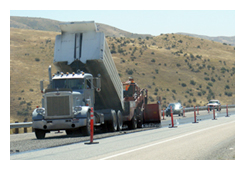

Seal coats protect highway surfaces from moisture intrusion
Every summer, particularly mid- to late-summer, seal coats and chip seal projects abound throughout the state. The maintenance activity often generates questions. Here are a few answers from ITD.
These applications protect the financial investment taxpayers have made in the road and also protect drivers. Here are the details:
Is it a seal coat or chip seal, and why are we doing it?
These two processes may differ slightly in a few minor details, but it’s mostly a difference in semantics. The principle is the same – apply a protective layer of rock chips and liquid asphalt to the surface of the road to extend the life of the surface and to provide better traction for drivers.
The ingredients in the two applications and the functions they serve have led many people to use the terms "seal coat" and "chip seal" almost interchangeably. In fact, a hybrid has recently evolved - the "chip seal coat."
It helps to minimize oxidation of the roadway surface. Oxidation causes the surface to dry out and the “pores” to open up to moisture, said Dave Kuisti, ITD's southwest Idaho engineering manager.
“During the freeze/thaw cycles, any moisture allowed into the road will expand and contract, eventually causing the surface to crack and deteriorate, which in turn leads to potholes, broken pavement and repairs.
The secondary reason for a seal coat is to create a rough, traction surface for winter driving,” Kuisti said.
 Seal coating begins by applying a layer of liquid asphalt, then a cover coat of rock chips. The highway is rolled and traffic allowed on to the roadway to help pack the surface. Like most ITD highway projects, the work is done by a general contractor with ITD inspecting the work to ensure quality standards are met. Seal coating helps to defer the cost of repairs that would be required much sooner without the protective application.
Seal coating begins by applying a layer of liquid asphalt, then a cover coat of rock chips. The highway is rolled and traffic allowed on to the roadway to help pack the surface. Like most ITD highway projects, the work is done by a general contractor with ITD inspecting the work to ensure quality standards are met. Seal coating helps to defer the cost of repairs that would be required much sooner without the protective application.
Why do we do it, especially over the top of a new, smooth roadway?
Many homeowners are dismayed when their new, smooth, asphalt road is seal coated or chip sealed. The smooth surface is covered with tiny rocks, eliminating many barefoot jaunts to the mailbox and potentially increasing the road-rash factor for bicyclists, skateboarders or other recreationists. However, a properly applied seal coat can add several years of service to a roadway by sealing the surface against weather and wear.
It is unfortunate timing that the best time to apply the seal coat is in the heat of the summer, but the primary benefit for drivers is greater traction when the snow flies several months later.
The work is done during the day to allow heat to help asphalt and rock bond to the roadway surface, providing a higher-quality finished product.
It may not be as appealing as it once was, but seal coating or chip sealing helps to protect the longevity of the road. Without the seal coat or chip seal, the asphalt is exposed and can begin to wear prematurely.
How can I avoid rock chips in my windshield or paint job?
Before any seal coat is final, crews "broom" or sweep the roadway surface to remove excess gravel. This usually is done multiple times overnight. In addition, following posted speed limits and increasing following distance will reduce the risk of windshield damage caused by loose gravel.
Windshield damage is often attributed to the seal coat but it is frequently caused by impatient drivers going too fast, whose tires throw the rocks indiscriminately at other vehicles.
Drivers also are reminded to slow down and watch for equipment and workers during and after seal coat applications. In a confined work area, safety is paramount.
Published 7-20-2012